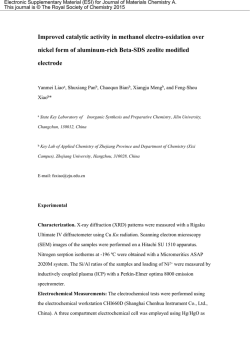
Porous graphene wrapped CoO nanoparticles for highly efficient
Electronic Supplementary Material (ESI) for Journal of Materials Chemistry A. This journal is © The Royal Society of Chemistry 2015 Porous graphene wrapped CoO nanoparticles for highly efficient oxygen evolution Yufei Zhao,a,b Bing Sun,a Xiaodan Huang,a Hao Liu,a Dawei Su,a Kening Sun,*b Guoxiu Wang*a 1Center for Clean Energy Technology, School of Chemistry and Forensic Science, Faculty of Science, University of Technology, Sydney, Sydney, NSW 2007, Australia. Email: [email protected] 2Beijing Key Laboratory for Chemical Power Source and Green Catalysis, School of Chemical Engineering and Environment, Beijing Institute of Technology, Beijing, 100081, China. E-mail: [email protected] Figure S1 SEM image of silica nanorod templates for the synthesis of PGE. Figure S2 Nitrogen adsorption/desorption isotherm of (a) PGE, (b) PGE-CoO and (c) GE-CoO. Figure S3 Low magnification SEM image of PGE-CoO. Figure S4 Element mapping of PGE-CoO. Figure S5 SEM images of pure CoO and GE-CoO. Figure S6 Nyquist plots of the PGE-CoO, GE-CoO and CoO modified electrodes in 0.1 M KOH solution. Figure S7 Electrochemical capacitance measurements: Cyclic voltammograms (CV) are performed in 0.1 M KOH solution in a potential window without faradaic processes, (a) PGE-CoO, (b) GE-CoO. Figure S8 (a) Equivalent electrical circuit used to model the OER process on PGECoO-modified GC electrode at various overpotentials, (b) The square symbols are experimental data and the red solid line are modelled by (a), (c) the low-frequency charge transfer resistance (Rct) and constant phase element (Cdl) as a function of the OER overpotentials for PGE-CoO-modified GC electrode in 0.1 M KOH. Figure S9 SEM images of PGE-CoO and GE-CoO after stability test.
© Copyright 2025
